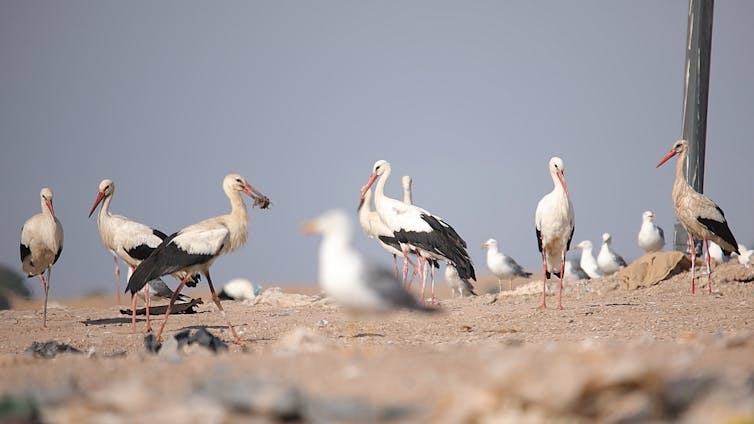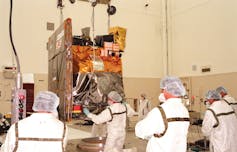Source: The Conversation – in French – By Julián Cano Povedano, PhD student, Estación Biológica de Doñana (EBD-CSIC)

Le plastique ne se déplace pas seulement par le vent ou la mer. En Andalousie, des milliers d’oiseaux en deviennent les livreurs involontaires, reliant les décharges humaines aux zones naturelles protégées.
L’image d’oiseaux envahissant les décharges et se nourrissant de nos déchets suscite des inquiétudes quant à ce qu’ils mangent réellement. On sait, par exemple, que ces animaux peuvent mourir après avoir ingéré du plastique. Mais ce qui est moins connu, c’est ce qu’il advient ensuite de ces plastiques avalés et comment ils peuvent affecter d’autres organismes partageant le même écosystème.
Notre groupe de recherche étudie depuis plusieurs années le transport de graines et d’invertébrés par les oiseaux aquatiques. Cependant, nous trouvions souvent du plastique, du verre et d’autres produits d’origine anthropique dans les pelotes de réjection – des boules rejetées contenant des restes organiques non digestibles – et dans les fientes que nous analysions. Nous nous sommes donc demandé : et s’ils transportaient aussi du plastique ?
La pollution plastique est l’une des menaces auxquelles notre société est confrontée. Si elle a été largement étudiée dans les écosystèmes marins, les informations sur la provenance et l’impact du plastique dans les zones humides, comme les lacs ou les marais, restent limitées.
Comment les oiseaux transportent-ils les plastiques ?
Dans de nombreux endroits, des oiseaux comme les cigognes, les goélands ou les hérons garde-bœufs effectuent chaque jour le même trajet. Ils se nourrissent dans les décharges puis se déplacent vers les zones humides pour se reposer. Là, ces espèces régurgitent des pelotes contenant le matériel impossible à digérer, comme les plastiques. Elles agissent ainsi comme des vecteurs biologiques, et leur comportement entraîne une accumulation de plastiques dans les zones humides utilisées pour le repos.
Mais quelle est l’ampleur de ce phénomène ?
Pour répondre à cette question, nous nous sommes concentrés sur trois espèces d’oiseaux courantes dans les décharges andalouses : le goéland brun, le goéland leucophée et la cigogne blanche. Nous avons suivi des individus équipés de GPS et prélevé des pelotes de réjection dans les zones humides reliées aux décharges par leurs déplacements.
Après avoir quantifié le plastique en laboratoire, nous avons finalement combiné les données GPS, les recensements des espèces et l’analyse des pelotes de réjection afin d’estimer la quantité de plastique transportée par l’ensemble de la population. Le travail et le traitement des échantillons réalisés dans le cadre du projet ont été présentés dans un documentaire consacré au transport de plastique par les oiseaux vers les zones humides aquatiques.
Des centaines de kilos de plastique chaque année
La lagune de Fuente de Piedra, à Málaga, est célèbre pour sa colonie de flamants roses. Il s’agit d’une lagune endoréique, c’est-à-dire que l’eau y entre par des ruisseaux mais n’en sort pas, ce qui entraîne une concentration de sels et de tout polluant qui y pénètre, y compris les plastiques.
En hiver, des milliers de goélands bruns venus se reproduire dans le nord de l’Europe s’y rassemblent. Nous estimons que cette population importe en moyenne 400 kg de plastique par an vers cette zone humide classée Ramsar, provenant des décharges des provinces de Málaga, Séville et Cordoue.
Une autre étude récente menée dans le Parc naturel de la baie de Cadix nous a permis de comparer les trois espèces mentionnées, qui fréquentent les mêmes décharges et partagent le parc naturel comme zone de repos. Au total, nous avons constaté que ces espèces transportaient environ 530 kg de plastique par an vers les marais de la baie de Cadix, mais chacune le faisait d’une manière légèrement différente.
Différences entre cigognes et goélands
La cigogne, plus grande, transporte davantage de plastique par individu que les goélands, car ses pelotes de réjection sont plus volumineuses. Cependant, le facteur le plus déterminant pour évaluer l’impact de chaque espèce reste le nombre d’individus effectuant le trajet entre la décharge et la zone humide. Dans notre étude, c’est encore une fois le goéland brun qui déplaçait le plus de plastique (285 kg par an), en raison de son abondance durant l’hiver.
La corrélation directe entre la fréquence des visites aux décharges et la distance à celles-ci est évidente, tant chez les goélands que chez les cigognes. Les écosystèmes situés à proximité des décharges sont donc les plus exposés à ce problème.
Notre étude montre également que les différences spatio-temporelles propres à chaque espèce se traduisent dans leur manière de transporter le plastique. Par exemple, nous avons observé que la zone de la baie de Cadix la plus exposée aux plastiques provenant du goéland leucophée se situe autour de ses colonies de reproduction. De plus, cette espèce transportait du plastique tout au long de l’année, tandis que les deux autres ne le faisaient qu’en lien avec leur passage migratoire.
Enfin, nous avons relevé certaines différences dans les types de plastiques transportés : la cigogne était la seule espèce à rapporter des morceaux de silicone depuis les décharges, pour des raisons encore inconnues.

Enrique García Muñoz, CC BY-ND
Impact et solutions
Les plastiques et leurs additifs peuvent causer de nombreux problèmes, non seulement pour les oiseaux eux-mêmes, mais aussi pour les organismes avec lesquels ils partagent leur écosystème – que ce soient des plantes ou d’autres oiseaux. Par exemple, les plastiques de grande taille peuvent provoquer des étranglements ou obstruer leurs systèmes digestifs.
Les effets des plastiques plus petits, ainsi que ceux de leurs additifs et des contaminants qui s’y fixent, passent souvent plus inaperçus : ils agissent notamment comme des perturbateurs endocriniens et entraînent des troubles métaboliques et reproductifs. De plus, ils peuvent entrer dans la chaîne alimentaire – passant d’un organisme à celui qui le consomme – et s’y accumuler progressivement à mesure qu’on en gravit les niveaux, affectant ainsi divers maillons de l’écosystème.
Résoudre ce problème n’est pas simple. Une directive européenne (1999/31/CE) prévoit l’utilisation de mesures dissuasives visant à limiter la fréquentation des décharges par ces oiseaux. Cependant, un débat persiste quant à leurs effets possibles sur les populations aviaires.
D’un autre côté, il existe une solution à notre portée, qui n’implique pas les oiseaux et que chacun peut appliquer : celle des célèbres trois « R » – réutiliser, réduire et recycler les plastiques que nous utilisons.
![]()
Julián Cano Povedano a reçu un financement du ministère espagnol de la Science, de l’Innovation et des Universités (bourse FPU). Les travaux réalisés ont également reçu le soutien financier de la Junta de Andalucía dans le cadre du projet de R&D+i GUANOPLASTIC (réf. PY20_00756).
Andrew J. Green a été le chercheur principal du projet « Aves acuáticas como vectores de plásticos y nutrientes entre vertederos y humedales andaluces : GuanoPlastic », financé par la Junta de Andalucía (réf. PY20_00756), mené d’octobre 2021 à mars 2023.
– ref. Les cigognes et les goélands transportent des centaines de kilos de plastique depuis les décharges jusqu’aux zones humides d’Andalousie – https://theconversation.com/les-cigognes-et-les-goelands-transportent-des-centaines-de-kilos-de-plastique-depuis-les-decharges-jusquaux-zones-humides-dandalousie-269304





